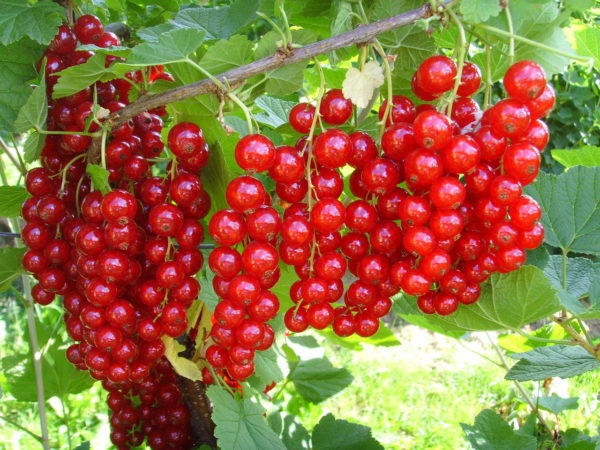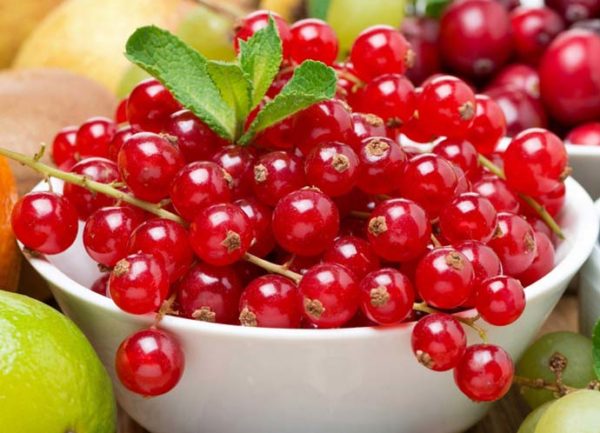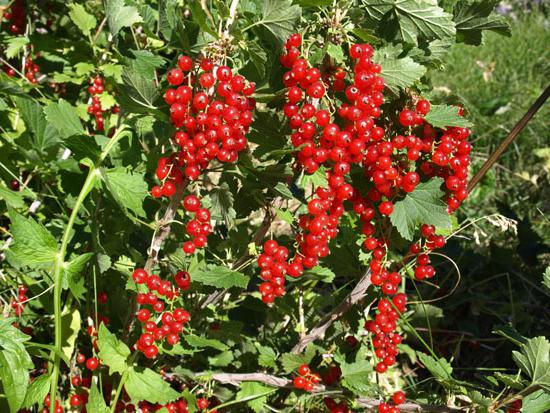It is difficult to find a gardener in Russia who would not grow currants on his plot. Our country accounts for 60% of the total currant production in the world. And all because it is not only the most useful berry culture, but also a beautiful decorative element of any garden.
A lush green bush, covered with bunches of bright juicy berries, many associate with summer, warmth and summer holiday. There are over 150 species of this plant, but one of the sweetest is considered to be a variety of red currants with the speaking name Sugar Loaf.
Table of contents
Description and characteristic of a grade of currant Sugar
Let's start with a description of the variety.Currant Sugar - bred hybrid type bred by domestic breeders. It is a shrub with upright branches. The leaves consist of five blades, the edges of which are covered with cloves. Buds are brown, rounded elongated.
The flowers are small, yellow-green. The length of the fruit hand can reach 9 cm, with the location on it up to 20 berries. The fruits themselves are bright red, medium size. Sugar currant is a dessert variety, its sweet, emitting a pleasant aroma, berries are used not only for winter preparations, but also with pleasure consumed fresh.
Advantages of currant sugar:
- High yield. With proper care, up to 7 kg of berries can be harvested from one bush.
- Dessert properties of the fruit.
- Winter hardiness The variety easily goes through harsh winters, including those with sudden temperature changes.
- Decorative. The red currant planted along the garden paths looks beautiful.
- The early ripe grade, fructifies from the end of June until the autumn.
- Unpretentious care.
- Gives yield for 25 years.
- The fruits are widely used, they are made of jam, compotes, wine and tinctures. Due to the high content of ascorbic acid, frozen or dried at low temperature, currant berries will be an excellent support for immunity throughout the winter.
- Resistant to pests. Of the diseases subject to only anthracnose.
- The fruits are well transportable. Long retain freshness, especially if collected clusters.

Among the shortcomings of the variety are:
- Not the largest size of the fruit.
- Low level of self-pollination (30%). If you plan to grow only this variety, then you should not expect large yields. To increase the yield, cross-pollination is necessary, for which other varieties of currant need to be planted on the plot.
Due to its unpretentiousness and resistance to cold, this variety, unlike the black one, is grown not only in the central and southern parts of the country, but also in Siberia and the Urals. At the same time, it is better to land in temperate latitudes in September, and in southern ones it is also possible in October. When spring planting, it is better to make it early, the optimal time will be the beginning or end of March, depending on the climate of your region.
In order for the currant sapling to settle down quickly, and soon began to bear fruit, you need to follow all the rules of its planting.

Rules for planting seedlings and caring for them
First of all, choose the right place for future landing. Currants love the sun, so do not plant it in shading. In low light conditions, the plant will develop poorly, its fruiting will shift to the upper part of the crown, and the berries will be ground.
Best of all, red currant will grow on sandy and light loamy soil, while areas with heavy clay and acidic soil will be unsuitable for it. Destructive and close location of groundwater. In this case, the bushes are better to plant on small mounds of earth.
When planting currants need to observe the following rules:
- Dig a hole for a seedling shallow (35-40 cm). And for planting several bushes, you can dig up one continuous trench.
- If the deadlines permit, let the pit stand for a week so that the earth settles.
- Place fertilizer on the bottom of the pit. To do this, mix fertile land with compost or rotted manure. If your soil is acidic, then add an additional oxidizing agent, in the role of which comes chalk, cement, or even ground egg shells.
- Pour water over the pit and place a seedling in it, keeping an angle of 45 degrees. Straighten the roots and fill them with soil so that the root collar goes 5 cm deep. This method of planting will create better conditions for the growth of the surplus roots and the formation of young shoots from buried buds. As a result, will form a powerful sprawling bush. If the landing is done directly, then the bush will eventually be single-stem.
- Stamp the ground and form a hole.
- Liberally pour a bush, pouring 3 buckets of water on it. To accelerate the growth of new roots, add the drug "Kornevin" in the water.
- Immediately after planting, cut off all the shoots by a third. Such pruning is guaranteed to give a good growth in the first year of the plant’s life.

As mentioned earlier, Sugar Currant is very unpretentious, and can grow with almost no maintenance. But, if you want to get record harvests of berries, then you should pay attention to the following procedures:
- Top dressing. The first few years, the young plant can be fed with a solution of nitroammophoska. On one bush dilute the matchbox means in 10 liters of water. This method allows you to accelerate the growth of shoots and quickly form a powerful bush. It will also be good to introduce nitrogen fertilizers in the spring - urea or ammonium nitrate. Dosage - 10g per 1 sq. M.
- Crop. An adult plant consists of 15-20 large branches. To come to this, each spring, leave only 2-3 powerful shoots, and remove all the little things. It is important that the saved shoots grow in different directions.
- Caring for the pristvolny circle. With the onset of spring, the ground under the currant should be well loosened with a rake and covered with humus or compost.
- Watering. Sugar currant is very moisture-loving, and for regular watering will thank you a good harvest. It is important to provide abundant watering during the formation and growth of the fruit, otherwise they may crumble. Water is poured at the root, without moistening the plant itself.During the dry season, currants are watered every 10 days for 5 buckets of water.
- Weeding from weeds.
- Treatment for pests and diseases.
Consider the measures to combat pests and currant diseases in more detail.
Diseases and pests of red currant and measures to combat them
Red currants are less susceptible to diseases and attacks of pests than black ones. And, in particular, the variety currant Sugar, has good resistance to most diseases and insects. The only thing worth protecting yourself in advance is anthracnose.
Anthracnose - This is a fungal type of disease, common in regions with a humid climate. Spores of fungi spread by rain, wind and insects. Plants with mechanical damage and weakened by lack of care are quickly infected.
Depressed spots cause a disturbance in the normal movement of nutrients inside the plant. As a result, when the humidity is high, the branches will rot and break, and in dry weather they will crack.If time does not stop the development of the disease, the aboveground part of the plant will die completely.

Measures to combat this disease - the timely removal of diseased parts of the bush and spraying fungicides. Spraying is enough to spend 2-3 times with a break of 15-20 days. To do this, the drugs Oxyhom, Yamato, Kuproksat, Fundazol, Acrobat MC, Chloroxide copper are suitable. As a prophylaxis of anthracnosis is used:
- Processing seedlings before planting a one percent solution of copper sulphate. To do this, they are immersed in the solution for a couple of minutes and then thoroughly washed with water.
- Processing of adult plants is carried out before budding. For these purposes, also suitable solution of copper sulfate, or Nitrofen.
- Top dressing currant phosphorus-potassium fertilizers, because one of the causes of anthracnose is a deficiency in the soil of potassium and phosphorus.
Pests of red currant are insects such as spider mites, currant bud moth, currant glass bowl. However, the variety currant Sugar is highly resistant to insect pests. To find them on the plant can be extremely rare.If you still want to protect the crop by 100%, then you can perform such simple preventive actions:
- From the occurrence of spider mites, the plants are sprayed a couple of times a season with an infusion of wormwood or tobacco.
- From currant bud moth, the bushes are sprinkled with a solution of mustard.
- The appearance of a currant glass bowl will help to avoid loosening the soil under a shrub in early spring, while the pest larvae are still sleeping in it. For reliability, you can still sprinkle the ground with wood ash or ground pepper.
Like other hybrids, the Sugar Loaf currant variety will not require much effort when it is grown. This unpretentious type of plant is recommended for cultivation for novice gardeners, as well as those people who can not afford to spend much time in the summer cottage. In addition, Sugar Currant is one of the most delicious and fruitful varieties, which will provide you with a useful berry for more than a decade.
